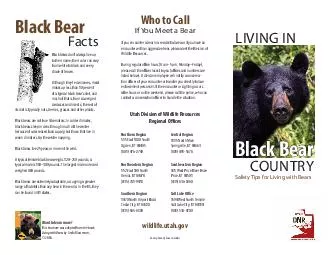

Although theyre carnivores meat makes up less than 10 percent of a typical black bears diet and much of that is from scavenged carcasses and insects the rest of its diet is typically nuts berries grasses and other plants Black bears are not true hib ID: 19320
Download Pdf The PPT/PDF document "LIVING IN COUNTRY Safety ips for Living ..." is the property of its rightful owner. Permission is granted to download and print the materials on this web site for personal, non-commercial use only, and to display it on your personal computer provided you do not modify the materials and that you retain all copyright notices contained in the materials. By downloading content from our website, you accept the terms of this agreement.
LIVING IN COUNTRY Safety ips for Living with Bears Black Bear Facts Black bears don’t always live up to their name; their color can vary from white to black and every shade of brown. Although they’re carnivores, meat makes up less than 10 percent of a typical black bear’s diet, and much of that is from scavenged carcasses and insects; the rest of Who to Call ou Meet a Bear If you encounter a bear in a residential area or if you have an encounter with an aggressive bear, please alert the Division of Wildlife Resources. During regular o ce hours (8 am–5 pm, Monday–Friday), please call the o ce closest to you (o ces and numbers are listed below). A division employee will notify a conserva - tion o cer of your encounter or transfer you directly to law enforcement personnel. If the encounter or sighting occurs Southeastern Region 475 West Price River Drive Price, UT 84501 (435) 636-0260 Southern Region 1470 North Airport Road Cedar City, UT 84720 (435) 865-6100 Salt Lake O ce 1594 West North Temple Salt Lake City, UT 84114 (801) 538-4700 wildlife.utah.gov Black Bear Cover photo by Suzann Julien Want to learn more? This brochure was adapted from the book Living with Bears by Linda Masterson, © 2006. UTAH black bear OUNTRY Safe Recreation Camping —Keep a very clean camp; stash your food and trash; wipe down picnic tables; burn food o stoves or grills; avoid scented toiletries; don’t put anything in your tent that could attract bears; always sleep inside your tent. Hiking —Hike at mid day when bears are less active; hike in groups; make noise as you travel; double-bag food, trash and other products with odors (such as sunscreen) in zipped plastic bags; stay away from animal carcasses; leave your dog at home; keep kids in the center of the group. Cars and Campers —Like campsites, cars and campers should be kept clean; clean out the car every night, lock doors and close windows when away; secure food, trash, coolers, pet foods and other items likely to attract bears. Keeping Your Property Safe The best way to prevent bear con icts around your home is to make your home as uninteresting and unfriendly to bears as possible. Avoid Trash Trouble —Store trash in a secure loca - tion or in a bear-resistant container; put your trash out for pick-up in the morning, not the night before; clean your trash container regularly. Use Deterrents —The following tactics can help keep bears away from areas you don’t want them to be: bear unwelcome mats (wood planks with nails or screws protruding) in front of doors or windows; motion-activated lights or noisemakers; barking dogs; garden hoses or sprinklers; bear spray; pine sol or ammonia; radios. If a Bear Is in Your Yard —Be sure the bear is not cornered and has an obvious escape route, then assertively look at the bear, make loud noises, and, if necessary, spray the bear with water from a garden hose or use bear spray from a safe distance. The average black bear is signi cantly smarter than a German shepherd, widely regarded as the smartest dog. Photo by Larry Dalton and Linda Romin What to Do If You Encounter a Black Bear Black bears are shy and usually avoid c on tact with people, but encounters in the woods or other bear territory are possible. Remember these tips if you encounter a black bear in its territory: Don’t play dead. Instead, stand still, stay calm, and talk to the bear in a normal, calm voice. Avoid direct eye contact, as the bear may consider eye contact hostile. Don’t climb a tree. Bears are excellent climbers, and you don’t want to face the bear in the tree. Don’t run. Bears can run up to 35 mph; you can’t outrun it. Back away from the bear, but don’t turn your back. Know bear behavior. If a bear stands up, grunts, woofs, moans or makes other sounds, it’s not being aggressive. These are ways a bear gets a better look or smell, and expresses its concern about the situation. Use bear spray if you have it. Be sure to remove the safety cover and point it toward the bear. If the bear does attack, ght back. People have successfully defended themselves with whatever is handy, including rocks, sticks, backpacks, water bottles and their hands and feet. Photo by Suzann Julien Photo by Utah Division of Wildlife Resources